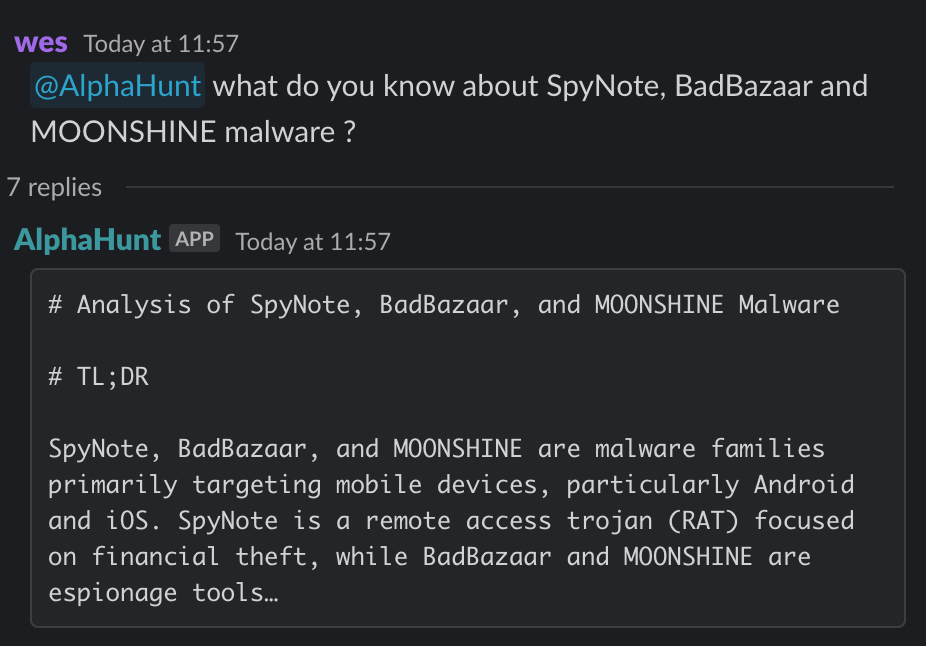Mobile Malware Threats: SpyNote, BadBazaar, and MOONSHINE
SpyNote, BadBazaar, and MOONSHINE are prominent mobile malware families primarily targeting Android devices.


(Have feedback? Did something resonate with you? Did something annoy you? Just hit reply! :))
Get questions from your boss, like this:
- what do you know about SpyNote, BadBazaar and MOONSHINE malware ?
Are you ready to level up your skillset? Get Started Here!
TL;DR
Key Points
-
- SpyNote, BadBazaar, and MOONSHINE are sophisticated mobile malware families targeting Android devices, with distinct motivations ranging from financial theft to state-sponsored espionage.
- Organizations should implement advanced mobile threat defense solutions and user education programs to mitigate these threats.
-
- SpyNote targets banking applications globally, while BadBazaar and MOONSHINE focus on espionage against specific ethnic groups, particularly in China, Taiwan, and Tibet.
- Establishing a robust incident response framework and collaborating with cyber threat intelligence communities are crucial for effective defense.
-
- These malware families are linked to state-sponsored groups like APT15 and Earth Minotaur, employing advanced evasion techniques and targeting sensitive geopolitical contexts.
- Continuous monitoring and analysis of malware activity, along with regular updates to security policies, are essential to stay ahead of evolving threats.
Executive Summary
SpyNote, BadBazaar, and MOONSHINE are prominent mobile malware families primarily targeting Android devices. SpyNote is a remote access trojan (RAT) focused on stealing sensitive information, especially from banking applications, and is distributed through deceptive websites mimicking legitimate app stores. BadBazaar is associated with espionage activities targeting Uyghur, Tibetan, and Taiwanese communities, linked to the Chinese APT group APT15. MOONSHINE employs sophisticated evasion techniques and is connected to state-sponsored actors, particularly the Earth Minotaur group.
The motivations behind these malware families vary, with SpyNote aiming for financial theft, BadBazaar focusing on surveillance of specific ethnic groups, and MOONSHINE being used for state-sponsored activities in sensitive geopolitical contexts. Historically, these malware families have evolved to exploit vulnerabilities in mobile applications, with SpyNote gaining prominence in 2023 through campaigns targeting banking apps and leveraging fake Google Play pages.
Countries primarily targeted include China, Taiwan, Tibet, and Uyghur regions, with sectors such as finance, government, civil society, technology, and healthcare being affected. The malware families are linked to other RATs and espionage tools, with similar malware like Anubis and Cerberus sharing tactics in targeting banking applications.
Recommendations for organizations include implementing advanced mobile threat defense solutions, developing targeted user education programs, establishing a robust incident response framework, collaborating with cyber threat intelligence communities, and continuously monitoring and analyzing malware activity. These measures are crucial to mitigate the risks posed by these sophisticated mobile malware threats.
Attribution
Origin
SpyNote, BadBazaar, and MOONSHINE are mobile malware families primarily targeting Android devices. SpyNote is a remote access trojan (RAT) known for harvesting sensitive data from compromised devices, often distributed through deceptive websites mimicking legitimate app stores. BadBazaar is associated with espionage activities, particularly targeting Uyghur, Tibetan, and Taiwanese communities. MOONSHINE employs sophisticated evasion techniques and is linked to state-sponsored actors, particularly the Earth Minotaur group.
Motivation
The motivations behind these malware families vary:
- SpyNote: Primarily aims to steal sensitive information, particularly from banking applications.
- BadBazaar: Used for espionage, focusing on surveillance of specific ethnic groups and individuals of interest to state actors.
- MOONSHINE: Believed to be used for state-sponsored activities, targeting individuals in sensitive geopolitical contexts.
Historical Context
- SpyNote: First identified in 2016, it has evolved over time, adapting its distribution methods to exploit vulnerabilities in mobile applications. It has been linked to various campaigns, including those targeting Netflix users.
- BadBazaar: Documented since 2022, it has been used in campaigns against Uyghur and Tibetan communities, with ties to the Chinese APT group APT15.
- MOONSHINE: Identified in 2019, it has been used by Earth Minotaur for long-term surveillance operations against Tibetan and Uyghur communities.
Countries Targeted
- China - Primary target for espionage activities, particularly against ethnic minorities.
- Taiwan - Targeted by both BadBazaar and MOONSHINE for surveillance.
- Tibet - Specific focus due to geopolitical tensions.
- Uyghur Regions - High targeting due to ongoing surveillance and oppression.
- Global - SpyNote has a broader target range, affecting users worldwide.
Sectors Targeted
- Finance - SpyNote primarily targets banking applications.
- Government - BadBazaar and MOONSHINE target government officials and activists.
- Civil Society - Focus on NGOs and groups advocating for human rights.
- Technology - Targeting tech-savvy individuals through deceptive applications.
- Healthcare - Indirectly affected through data breaches and espionage.
Recommendations, Actions, Suggested Pivots, Forecasts and Next Steps..
(Subscribers Only)


![[DEEP RESEARCH] Zero-Days Are a Distraction: 2025’s Biggest Losses Were Stolen Tokens + OAuth](/content/images/size/w600/2025/12/zz-3.png)


